|
Visiting
German vineyards, part 4
Gunderloch,
Rheinhessen
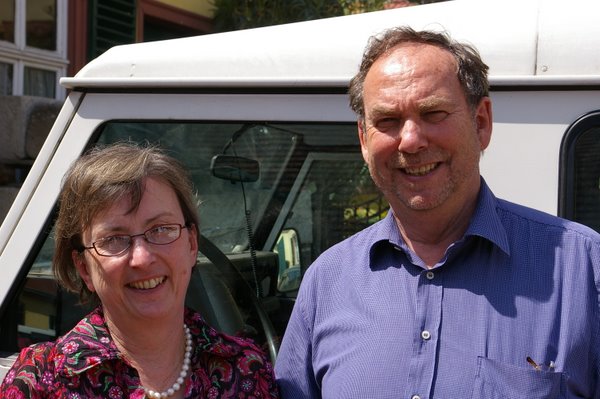
So
far in this series on German wine we’ve been in the Rheingau and
the Nahe. Now it is time to visit the Rheinhessen, and specifically
one of the top producers in the region—Gunderloch.
Agnes
and Fritz Hasselbach are the people behind the wine. When they
married in 1976 both were teachers. Agnes’ family owned Gunderloch,
but because none of the other children showed any interest, Agnes
and Fritz decided to leave a safe and secure income to take over the
responsibility of the family winery in 1979.

Looking
along the vineyards of the Rheinhessen (Rothenberg is in the close
field) down to Nierstein
In
1996 they took over another winery in nearby Nierstein, Anton
Balbach. Friedel, the owner, had taught Fritz, who was very
interested in half of the vineyards, close to Gunderloch, but not
interested in the remainder, which were flat fields. But it was all
or nothing, so overnight Gunderloch doubled in size to 24 hectares.
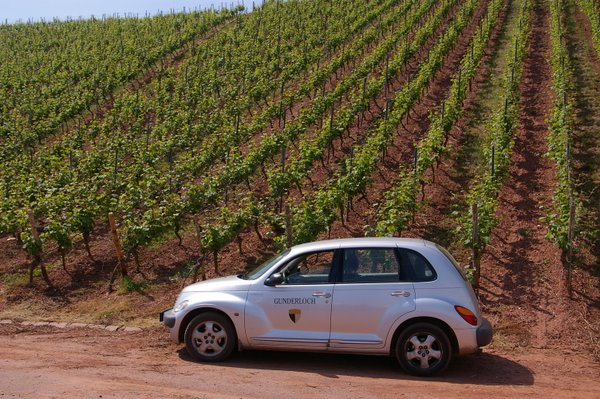
Gunderloch’s
vineyards are located on steep slopes overlooking the Rhine between
Nachenheim and Nierstein. The soil, red slate, is unique to the
Rheinhessen, and this slate was a sediment formed when the alps were
built. It makes a warm, minerally soil that Fritz says influences
all their Rieslings. According to Fritz, the Jean Baptiste Riesling
Kabinett really shows the minerality of the red slate.
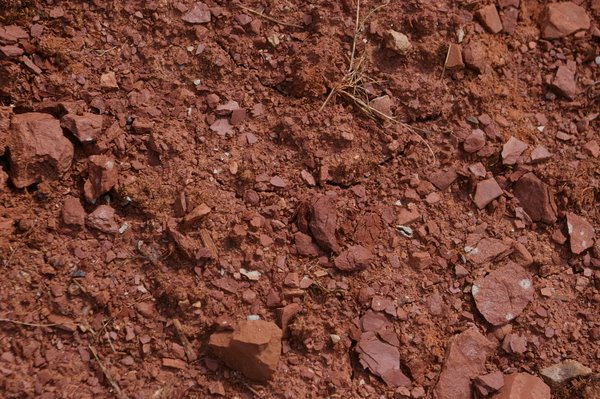
Riesling
is the bulk of Gunderloch’s production, accounting for 85%, with a
bit of Pinot Gris, Pinot Blanc and Sylvaner, as well as tiny amounts
of Sauvignon Blanc and Pinot Noir.
Fritz
is not terribly happy with the wine law. ‘We have a strange German
wine law that doesn’t say anything about the classification of the
vineyards, just the must weights.’ While he likes the Grosses
Gewächs (GG) classification of vineyards, he isn’t sure why it is
just for the dry styles. It would make sense that the GG vineyards
were GG for all styles of wine, not just the trocken styles, wouldn’t
it? ‘It is currently possible to chaptalize dry wines from GG
vineyards,’ he laments. ‘For us, the average yield for GG wine
is 20–25 hl/ha, but we have colleagues in Nierstein who make 20
000 bottles of GG wines. For us it is important not to chaptalize GG
wines. From 1 hectare of Rothenberg we make 2000 bottles maximum.’
He adds that there is a tasting panel for GG wines, with several
growers from the VDP involved, but no neutral person.

With
winemaking, Fritz says he has 27 years’ experience, but each
vintage is different. Earlier on, he used a centrifuge to clean the
must, then flotation. Now he simply chills and settles it for 12 h
at 9–10 °C. ‘We don’t use a flotation pump any more;
everything is naturally settled,’ he says, although he does fine
the must with bentonite. There’s
a strict selection in the vineyard, and for the Jean Baptiste
botrytis is selected out. Fermentation is very slow, at low
temperatures. Fritz says the range is 2–10 °C, but this sounds
absurdly low. He says that red slate soil leads to high tartaric
acid levels, and this can fall out. His father-in-law had problems
with acidity, which became too low, and malolactic would start.
The
wines are impressive across the board, ranging from the delicious,
nicely packaged Fritz’ Riesling to the more serious labels.
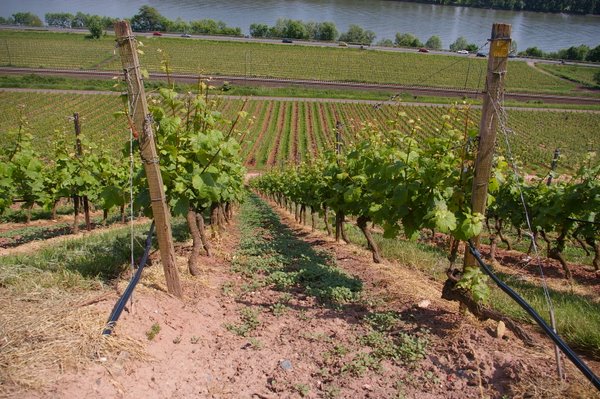
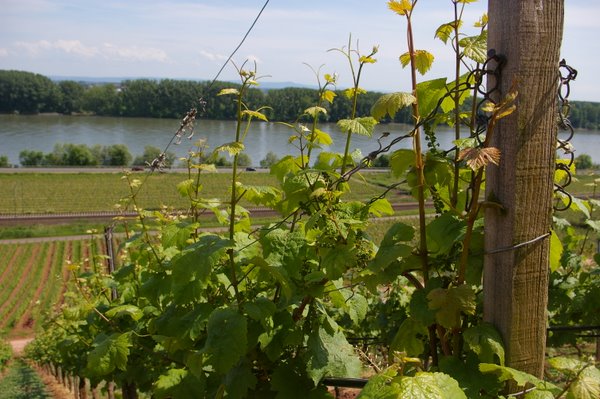
THE
WINES
Notes
from 05/09
Gunderloch
Nackenheim Rothenbery Riesling Trocken 2007
12.5% alcohol. Intense, flinty and mineral nose. Strong, pungent
and slightly smoky with a rich savoury quality. Powerful, with
almost meaty notes alongside the minerality. 93/100
Gunderloch
Jean Baptiste Riesling Kabinett 2008
Named created by the theatre writer who authored ‘The Happy
Vineyard’ in 1925. The main character in the play was Anges’
great grandfather, Karl Gunderloch. Very distinctive intense,
minerally nose. Crisp and limey with lovely freshness. The palate is
just off-dry (24 g/l rs) – the feinherb style. Green apple fruit
with nice texture and a long spicy, minerally finish. 91/100
Villa
Gunderloch Riesling QbA 2008
Fresh, fruity, appley and mineral. Intense, fruity and fresh on
the palate with nice balance and a bit of grapefruit freshness.
88/100
Gunderloch
Nackenheim Rothenberg Riesling Spätlese 2008
Strongly mineral and flinty, with a matchstick edge to the nose
and light fruity characters. The palate is rich and quite sweet but
also precise and fruity with a smooth mineral edge. Distinctive and
quite complex. Lovely texture. 92/100
Gunderloch
Nackenheim Rothenberg Riesling Auslese 2008
Mineralic, tight nose is crisp with some limey notes. The palate
is rich-textured with lovely sweet lemony fruit and some apricot
notes. Good acidity. Deliciously fruity and sweet. 92/100
Gunderloch
Nackenheim Rothenberg Riesling Auslese Goldkapsel 2007
By the regulations this could be a TBA, but they say they’d
expect more weight in a TBA. Gold colour. Rich, peachy and apricotty
with real viscosity and a fat texture. Lush with spicy complexity
and broad tropical fruit notes. 93/100
Gunderloch
Nackenheim Rothenberg Riesling Beerenauslese 2007
Deep gold. Wonderfully sweet, rich and intense with herbs,
lemon, minerals, apricot and melon flavours. Long spicy finish with
perfect balance. It’s the red slate, apparently. 94/100
Notes
from 05/10
Fritz’s Riesling 2009
11% alcohol. Beautifully pure with bright fresh lemon and apple
notes. Some melony richness as well as some sweetness. Beautifully
balanced. 88/100
Gunderloch
Jean Baptiste Riesling Kabinett 2008
Very expressive with taut lime and mineral notes. Off-dry and
beautifully balanced with fresh lemony notes and some pronounced
minerality. Lovely precision. 92/100
Gunderloch
Riesling QbA 2008
Intensely mineral, herby nose with taut, spicy, limey notes. The
palate is fresh with apple and pear notes as well as some herbal
depth. Off-dry. 89/100
Gunderloch
Rothenberg Nackenheim Riesling Auslese 2006
Very lively and intense with notes of lime, honey and spice as
well as melon. The palate shows beautiful melon fruit with some ripe
apple notes. Sweet and rich but showing beautiful balance. 94/100
GERMANY
SERIES
 Part
1: Introduction Part
1: Introduction
 Part
2: Leitz, Rheingau Part
2: Leitz, Rheingau
 Part
3: Dönnhoff, Nahe Part
3: Dönnhoff, Nahe
 Part
4: Gunderloch, Rheinhessen Part
4: Gunderloch, Rheinhessen
 Part
5: Paul Furst, Franken Part
5: Paul Furst, Franken
 Part
6: Dr Loosen, Mosel Part
6: Dr Loosen, Mosel
Wines
tasted as 05/09
Find these wines with wine-searcher.com
Back
to top
|

